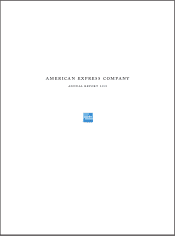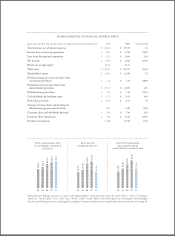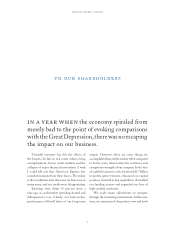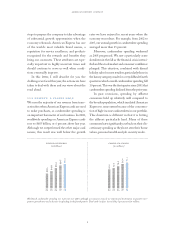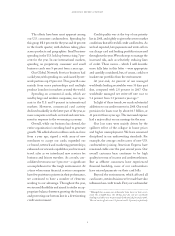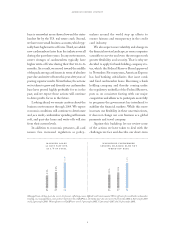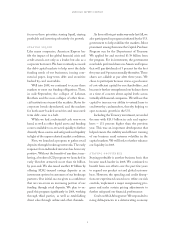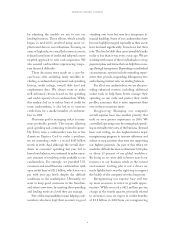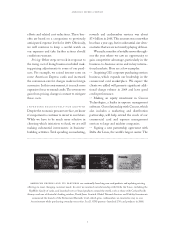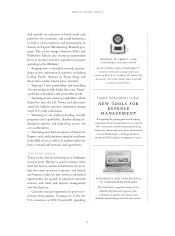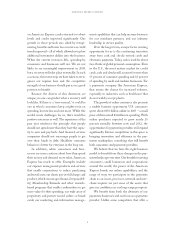American Express 2008 Annual Report Download - page 7
Download and view the complete annual report
Please find page 7 of the 2008 American Express annual report below. You can navigate through the pages in the report by either clicking on the pages listed below, or by using the keyword search tool below to find specific information within the annual report.american express company
5
focus on three priorities: staying liquid, staying
profitable and investing selectively for growth.
staying liquid
Like many companies, American Express has
felt the impact of the global financial crisis and
credit crunch, not only as a lender but also as a
corporate borrower. We have routinely accessed
the debt capital markets to help meet the daily
funding needs of our businesses, issuing com-
mercial paper, long-term debt and securities
backed by card receivables.
Well into 2008, we continued to access these
markets to meet our funding obligations. Then,
in mid-September, the collapse of Lehman
Brothers and the near-collapse of other finan-
cial institutions stunned the markets. Rates for
corporate bonds skyrocketed, and the markets
for both asset-backed securities and unsecured
term debt came to a halt.
While we had a substantial cash reserve on
hand, as well as other liquid assets and funding
sources available to us, we acted quickly to further
diversify those sources and safeguard our liquidity
in light of the unprecedented market conditions.
First, we launched a program to gather retail
deposits through brokerage networks. The early
response from individual investors has been very
positive. Without the benefit of any direct mar-
keting, a brokered CD program we launched in
early October attracted more than $6 billion
by year-end. We also raised another $7 billion by
offering FDIC-insured savings deposits as an
investment option for customers of our brokerage
partners. Our initial success gives us confidence
that we can secure an increasing portion of our
funding through retail deposits. We plan to ex-
pand this program significantly in 2009, working
through third parties, as well as establishing
direct sales through online and other channels.
As these efforts got underway early last fall, we
also participated in programs initiated by the U.S.
government to help stabilize the markets. Most
prominent among them was the Capital Purchase
Program run by the Department of Treasury.
We applied for and received $3.39 billion from
the program. For its investment, the government
now holds preferred shares in American Express
that will pay dividends of 5 percent for the first
five years and 9 percent annually thereafter. These
shares are callable at par after three years. We
chose to participate because it was a good source
of cost-efficient capital for our shareholders, and
because it further strengthened our balance sheet
at a time of concern about capital levels across
virtually all financial companies. We will use this
capital to increase our ability to extend loans to
creditworthy cardmembers, thereby helping to
spur economic growth in the U.S.
Including the Treasury investment, we ended
the year with $20.5 billion in cash and equiva-
lents – 131 percent higher than the previous
year. This was an important development that
helped ensure the stability and efficient running
of our business amid extreme volatility in the
capital markets. We will look to further enhance
our liquidity in 2009.
staying profitable
Staying profitable is another business basic that
became much harder in 2008. We continued to
benefit from our efforts over the past few years
to expand our product set and global customer
base. However, the spending and credit disrup-
tions we experienced caused us to refine our risk
controls, implement a major reengineering pro-
gram and make certain pricing adjustments to
further safeguard our financial performance.
Credit and Risk Management: We responded to
rising delinquencies in a deteriorating economy

